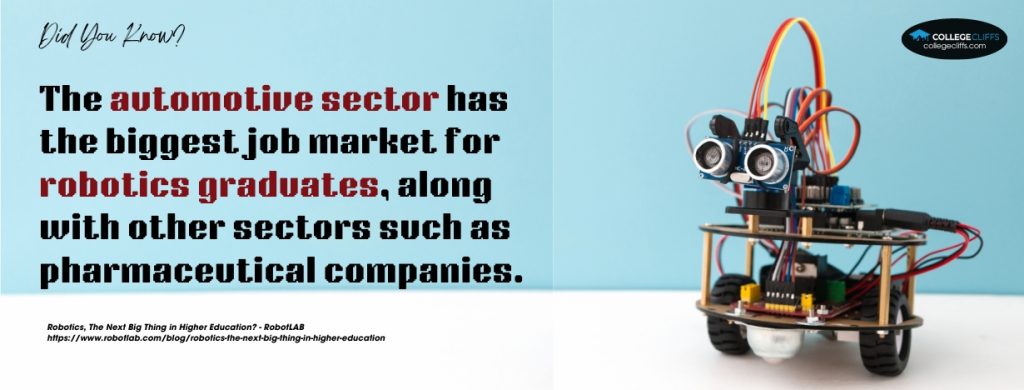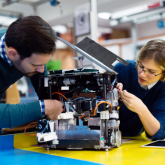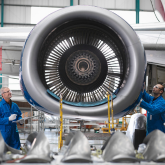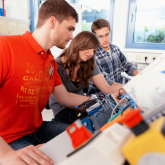Robotics Wars: Which 15 Degrees Will Get You In on the Competition?
Find your perfect college degree
In this article, we will be covering...
Our ancestors would have never imagined the world we live in now, where everyone and everything uses technology to connect with others. Technology has allowed the scientific community to advance in their discoveries and research.
It also inspires educators and scientists to create, invent, and innovate new approaches to teaching science and technology.
One of the best examples of how far human ingenuity has advanced is the creation and utilization of robots. Robotics is one of the most diverse and critical fields of science, encompassing various fields like manufacturing, healthcare applications, transportation, and communications.

In addition to being created to help men with their tasks, robots are now used for fun educational activities. These robotics competitions have become a breeding ground for innovation and creativity, which has attracted more people to jump in on STEM education.
Have you ever watched movies, news, or short videos about robotics competitions and found them amusing and thrilling? Well, this article will be one of your best reads. We’ll talk about robotics competitions and how to choose the best degree. You’ll also know which industries use robotics the most, giving you a glance at your future career paths.
What Happens in Robotics Wars
Robots are designed, built, and programmed by individuals or teams to compete against one another in various challenges during robotics competitions. These contests allow robotics enthusiasts, students, engineers, and researchers to demonstrate their expertise, originality, and inventiveness.
A lot of robotics competitions have been popping out recently, and each has its own set of guidelines, goals, and difficulties. It appears as though fresh initiatives are launched annually. Regardless of your interests—space, seas, rovers, drones, etc.—fantastic competitions are available to support your learning and development!
Some of the more famous robotics competitions are listed below.
Educational Robotics Competitions
- FIRST Robotics Competition (FRC): Focused on high school students, FRC challenges teams to build large-scale robots to compete in complex games.
- VEX Robotics Competition: Ideal for middle and high school students, VEX competitions involve smaller robots competing in games or challenges.
Robot Combat Competitions
- BattleBots: Robots designed for combat face off in an arena to disable or immobilize their opponents.
- Robot Wars: Similar to BattleBots, Robot Wars features robots equipped with various weapons competing in an arena.
Search and Rescue Competitions
- RoboCup Rescue: Teams design robots to navigate simulated disaster scenarios, locating and rescuing victims in a structured environment.
Autonomous Vehicle Competitions
- DARPA Grand Challenge: Autonomous vehicle competitions that involve navigating vehicles through challenging courses, fostering advancements in self-driving technology.
Drone Racing
- Drone Racing Leagues: Competitions where pilots race custom-built drones through challenging courses, testing speed and agility.
Sumo Robotics
- Robot Sumo Wrestling: Robots designed to push each other out of a ring, mimicking traditional sumo wrestling but with autonomous or remote-controlled robots.
Humanoid Robot Challenges
- RoboCup Soccer: Humanoid robots compete in soccer matches, demonstrating advancements in robotics, artificial intelligence, and team coordination.
Space Robotics Competitions
- NASA Robotic Mining Competition: University teams design and build robots for mining tasks simulating extraterrestrial environments.
Medical Robotics Competitions
- RoboCup@Home Healthcare Robotics: Robots designed to assist with healthcare-related tasks, promoting advancements in assistive robotics.
Agricultural Robotics Competitions
- Field Robot Event: Challenges teams to build robots capable of autonomously navigating and performing tasks in agricultural fields.
Importance of Robotics Wars
Robotics wars provide an extensive platform for imparting a variety of STEM abilities and critical soft skills that are essential in the robotics industry. The following are some particular abilities that players can pick up:
- Problem-Solving: Teams frequently face unique obstacles during competitions that they must conquer. To uncover answers, this challenges participants’ critical and innovative thinking.
- Programming: Coding skills are necessary for both building and managing a robot. Participants gain knowledge of programming languages like Python, Java, or C++ and learn how to use these abilities to program their robots to carry out particular tasks.
- Engineering Design: Participants gain knowledge of the entire robot design process, from ideation to execution. To do this, one must comprehend mechanical and electrical engineering fundamentals.
- Mathematics: A lot of math can be involved in robotics, from algebra and calculus geometry for designing the robot and its movements to programming its activities.
- Scientific Principles: Learners gain knowledge of various scientific concepts, including motion, force, and energy concepts in physics, which are essential to comprehend how a robot interacts with its surroundings.
- Technology Literacy: Participants develop familiarity with various technologies, including robotics hardware and software, control systems, and sensors.
There are other benefits of robotics wars.
Competitions in robotics are a great way to network as well. These competitions have several participants, including seasoned robotics professionals, employers, mentors, and like-minded peers. You can interact with those people, build a connection, and create your very own professional network.
You’ll also gain future employment prospects, mentorships, and internship opportunities. These competitions heavily emphasize teamwork, and the robotics industry values the capacity for productive collaboration.
You’ll have access to the newest innovations and trends in the area and get a peek into the kinds of solutions in demand and the sector’s needs. This knowledge can direct your career and educational choices, aligning you with industry demands.
How To Choose the Best Degree for Robotics
Robotics is not something you learn overnight. Since it encompasses several STEM fields, it could take years before you could actually build a working and durable robot. For this reason, you must choose a degree program that will equip you with the right skills and knowledge to build a functioning and stable robot.
Choosing the best degree for a robotics career is not easy, but it doesn’t have to be so difficult. The first thing you need to consider is your professional objectives. Think of what you’ll do with your degree. Here are some guideline questions that will help you choose the best program for your interests:
- Why do I want to study robotics?
- Where do I want to work?
- What kind of robotics am I interested in creating or working with?
- Will I pursue a master’s or PhD program?
Choosing the right degree and college for your particular objectives will be easier if you take the time to think about what you want from a robotics career in the future.
After you’ve made a list of potential colleges for robotics, you should assess each program. Ensuring the robotics program is accredited and acknowledged by the appropriate organization will provide you with the knowledge and skills needed to enter the field, which is crucial.
Look for colleges that have robotics labs or maker spaces on campus. Building and testing robots require space, and an on-site lab indicates that you will engage in significant hands-on learning.
Next, compare the kinds of courses required for a robotics degree at each college. Examine the course descriptions, get to know the professors, and watch for special offers like accelerated learning, practicums, and internships. While prerequisites will vary per university, you should consider the following courses:
- Mechatronics
- Robotics Programming
- Control Systems
- Computer Vision
- Machine Learning for Robotics
- Artificial Intelligence
- Kinematics and Dynamics
- Embedded Systems Design
- Sensors and Actuators
Industries That Use Robotics
Healthcare
Robotics in healthcare assists surgeries, rehabilitation, and diagnostics, improving precision and outcomes. The career outlook is robust, with growing demand for experts in surgical robotics, medical imaging, and robotic-assisted procedures.
Agriculture
In agriculture, robots automate tasks like planting and harvesting, enhancing efficiency. The industry seeks professionals in agricultural robotics, drone technology, and data analytics. Career opportunities are expanding with the rise of precision farming.
Logistics
Logistics relies on robots for warehouse automation, optimizing order fulfillment, and inventory management. Careers in logistics robotics involve designing, programming, and maintaining robotic systems for streamlined distribution processes.
Pharmaceutical
Robotics is pivotal in drug discovery, development, and manufacturing in the pharmaceutical industry. Career opportunities in pharmaceutical robotics involve automation solutions, ensuring precision in drug formulation and quality control tasks.
Manufacturing
Manufacturing utilizes robotics for assembly line automation, improving production efficiency. Professionals in manufacturing robotics focus on roles in robot programming, maintenance, and process optimization. The career outlook is strong as automation continues to reshape manufacturing.
Construction
Construction benefits from robots in tasks like bricklaying and welding, enhancing safety and efficiency. Construction robotics care involves designing, managing, and integrating robotic systems for improved building processes. Job prospects are growing as construction embraces automation.
Consumer goods
Robotics in consumer goods manufacturing ensures precision and speed in production. Careers involve designing and implementing automated packaging, labeling, and quality control solutions.
Packaging and shipping
Automation in packaging and shipping utilizes robotics for sorting, packing, and labeling. Professionals design robotic systems to enhance speed and accuracy in these operations.
Palletizing
Palletizing robots automate stacking goods on pallets for efficient storage and transportation. Careers involve programming and maintaining robotic systems adaptable to diverse palletizing needs.
Food
The food industry employs robotics for harvesting, sorting, and packaging tasks. Careers involve developing automation solutions adhering to food safety standards and optimizing production. The outlook is strong as the industry prioritizes efficiency and quality in food production.
Check out the fun:
The Best Degrees for Robotics
Dedicated Robotics Major

Several universities, such as the Massachusetts Institute of Technology (MIT) and Carnegie Mellon University, have been at the forefront of robotics learning for decades. These institutions offer cutting-edge robotics engineering, artificial intelligence, and automation programs.
Students at MIT can explore the renowned Computer Science and Artificial Intelligence Laboratory (CSAIL), while Carnegie Mellon’s Robotics Institute is a pioneer in robotics research and education.
As a quickly expanding field, robotics engineering offers various focuses. Some programs may offer a combined curriculum that discusses several engineering fields, while others offer a career-focused curriculum with special concentrations, such as algorithms, AI, and other AI-related topics.
Most colleges and universities in the United States offer academic counseling services that guide students in choosing which robotics-specific program will best suit their needs. You can use these opportunities to develop career-focused abilities and advanced competency in robotics.
Although coursework may vary, some of the most important courses in dedicated robotics majors include:
- Robotics Programming
- Robot Kinematics and Dynamics
- Sensors and Perception
- Machine Learning for Robotics
- Human-Robot Interaction
- Robotic Systems Integration
- Robotics Capstone Project
Aerospace Engineering

Aerospace Engineering is the main area of engineering that focuses on developing systems and equipment used for aircraft, including spacecraft and airplanes. Traditionally, the field has concentrated on atmospheric and space flight issues. But, due to its intense and rigorous coursework, this is one of the most sought-after degree programs taken by those who want to participate in the robotics industry.
Students pursuing a degree in Aerospace Engineering delve into coursework that covers the fundamentals of aircraft and spacecraft design and integrates principles from mechanical engineering, control systems, and artificial intelligence.
Sample coursework that will help you develop skills to win in robotics competitions, especially those dedicated to locating the most useful robotics for extraterrestrial activities:
- Propulsion Systems
- Spacecraft Systems Engineering
- Avionics and Navigation
- Autonomous Systems and AI in Aerospace
- Orbital Mechanics:
- Space Robotics
- Advanced Controls for Aerospace Applications
Artificial Intelligence

AI is one of the most important aspects of modern technology and is being used everywhere, from healthcare and financial services to private businesses and government agencies. In a survey, 35% of organizations employ AI, and 42% have looked into integrating AI into their business plans.
Robotics and artificial intelligence are distinct concepts. Artificial intelligence emulates the human mind for learning, problem-solving, and decision-making, while robotics involves programming robots for specific, predictable, and repetitive tasks.
However, AI and robotics are coexisting fields. Robotics and AI combined can be a potent tool for any company or organization. A wide range of industries, including healthcare, automotive, retail, manufacturing, education, logistics, transportation, and more, are seeing a rapid uptake in AI-driven robotic solutions.
Look out for these AI courses:
- Artificial Intelligence for Robotics
- Object Tracking and Localization
- Machine Learning
Bioengineering

Bioengineering majors study general biology and its applied engineering techniques. These majors aim to develop students’ knowledge about the issues in various natural science fields.
The field includes several branches, including agriculture, pharmaceuticals, natural resources, and food, each focusing on a particular aspect of biological and engineering coherence. As a result, its methods are used in a wide range of industries, such as technology, healthcare, and the environment.
Bioengineers are essential to robotics because they apply their knowledge of biology, biomechanics, and medical sciences to the development of robotic systems. A new discipline called “bio-robotics” or “biorobotics” has emerged due to the cooperation between bioengineering and robotics.
Six thousand Da Vinci surgical systems have been used worldwide to perform over two million surgical procedures since 2000, cutting down on waiting times and the number of doctors required. Caregiving is another area where bio-robotics is being utilized.
Some of the most common courses in Robotics include:
- Biomechanics and Biomimicry
- Neuroengineering
- Human-Robot Interaction
- Rehabilitation Robotics
Computer Programming

Programming involves instructing a computer on what actions to take to solve problems, which is basically the role of robotics. Programming can be viewed as an interaction between humans and computers, wherein humans write instructions (code) in a language that computers can comprehend for a computer to obey. Robotics is under the purview of computer programming.
Computer programming will develop your mathematics, logic, and analytics capabilities, which are crucial for success in robotics. Upon completion, you can apply for jobs that task you with creating and testing software for industrial and manufacturing robots and analyzing designs, blueprints, and requirements.
You’ll be qualified to set up robots, test programs, and monitor quality. You can create software according to technical specifications, assess end-user needs, create prototypes, and troubleshoot issues.
With the skills and techniques you’ll learn in this major, you’ll be able to create a robot that has a chance to win in any robotics competition.
Computer programming majors will require you to take certain mathematics and program courses, including:
- Python
- C and C++
- Software Development
- Computer Systems Analysis
- Software Testing
Computer Science

Computer science knowledge is essential to robotics because it allows machines to view and understand their environment. By looking at pictures or video streams, robots may pick up crucial information about objects, their positions, and their properties.
Computer science provides a strong foundation for understanding and working with the core principles that are crucial in the field of robotics. This major trains you to contribute significantly to developing, programming, and deploying robotic systems across various industries and applications.
Graduates can become computer scientists and create user interfaces and modules for smooth functionality. Their work enables robots to learn and adapt through machine learning and artificial intelligence.
Important courses in computer science include:
- Cloud Computing
- Encryption
- Data Structures
- Mathematics
- Python
- Java
- CSS
- HTML
Electrical Engineering

Electrical engineering is one of the major subfields of engineering. This major is dedicated to studying electricity, electronics, and electromagnetics, which are all essential in building robust robotics systems.
Top engineering schools offer several electrical engineering specializations, including robotics. But even if an electrical engineering degree does not provide a robotics specialization, you’ll still be able to learn the basics of robotics.
This major offers a curriculum that equips you with the information and abilities needed to work with robots, making it one of the top choices for someone who wants to win in robotics competitions. You will gain knowledge of the design and manufacturing processes for mechanical systems. The development of successful and efficient robots requires an understanding of this.
Topics covered in electrical engineering majors that are directly related to robotics include:
- Advanced Programming
- System Design
- Manipulator kinematics and dynamics
- Localization and Mapping
- Artificial Intelligence
Industrial Engineering

Industrial engineering is a training ground to make the world around us function better. While the roles and tasks of industrial engineers vary, their main task is to identify the best ways to integrate people, equipment, and information in the workplace.
They also design new plans, routes, and frameworks to save money, maximize energy use, and improve overall quality.
Industrial engineers are crucial in developing robotics, especially in the manufacturing and pharmaceutical industries. While this major may not cover all the specific technical aspects of robotics, you will have the foundations required for robotics competitions, such as mathematical solid, engineering, and science knowledge.
Teams that include individuals with an IE background can bring valuable perspectives, management skills, and optimization strategies to complement the technical expertise of team members from other disciplines. The ability to approach robotics challenges holistically and systems-oriented can contribute significantly to a team’s success in competitions.
As an IE major, you’ll delve into several complicated but very critical courses required in all fields of robotics and engineering, including:
- Design And Analysis Methods
- Modeling and Simulation
- Human Factors in Design
- Industrial Applications for Statistics and Probability
Materials Science

The materials science major is crucial in shaping a professional’s competency in the robotics industry. This major delves into materials’ properties, processing, and application, offering a profound understanding of how different substances behave under varying conditions. In robotics, this knowledge is invaluable for selecting materials aligning with the specific requirements of robotic components.
A materials scientist can optimize a robot’s structure for strength-to-weight ratio, durability, and thermal conductivity. Understanding the properties of nanoscale materials allows for the development of advanced sensors, actuators, and other essential components.
Additionally, expertise in materials science ensures the design and construction of robots capable of withstanding diverse environments and tasks, contributing to the overall efficiency, reliability, and innovation within the field of robotics.
In this major, you’ll explore various courses related to the invention of robotics systems. You can apply this knowledge to create better robotics systems for multiple industries. You can partner with other professionals in robotics, join competitions, and have a high chance of winning. These courses include:
- Smart materials and nanotechnology
- Machine Theory and Production Lines
- Advanced Mathematics for MEM
- Analog Electronic Circuits
- Microcontrollers and Embedded Systems
Mathematics or Physics

Mathematics and physics are used in any engineering concepts, allowing you to cultivate robotics competencies.
Maths plays a crucial role in learning robotics, as it helps understand concepts like algebra, geometry, statistics, calculus, and differential equations. Algebra deals with symbols representing numbers and quantities, while geometry studies sizes, shapes, and positions.
Statistics analyzes data for robots to perform tasks, while calculus studies the rate of change and differential equations. These concepts contribute to the development of robots, machines that replicate and assist human actions.
On the other hand, physics—which studies the science of matter, energy, and their interaction—is among the backbone of robotics. Physics principles guide the design and optimization of sensors and actuators, ensuring that robotic systems operate effectively in diverse environments.
Proficiency in these disciplines equips individuals with the analytical and problem-solving skills necessary for tackling the intricacies of robotics, from conception to implementation.
Mechanical Engineering

A mechanical engineering major teaches you how to design, analyze, and improve mechanical systems, essential for working with robots. In this program, you learn about kinematics, dynamics, and materials science and gain the skills to create robust and efficient robot structures.
As you go through your studies, you become good at putting together sensors and actuators, known as the brains and muscles of robots, to make them do what they’re supposed to do. This knowledge is handy, especially in robot competitions where precision and reliability are essential.
With what you learn in mechanical engineering, you can stand out by designing special parts for competitions, making robots use energy wisely, and ensuring they stay in one piece.
Knowing thermodynamics and fluid mechanics (how things move in liquids and gasses) also helps. This knowledge is like having a secret weapon, especially in robot competitions where robots need to work in different places.
Sample coursework of mechanical engineering degree programs:
- Computer-Aided Design
- Thermodynamics
- Dynamic Systems and Controls
- Engineering Ethics and Professionalism
- Machine Design
- Material Science
Mechatronics

Mechatronics is a relatively new discipline combining computer science, electrical, and mechanical engineering to create, construct, and manage intelligent machinery. This major urges students to participate in a multifaceted curriculum, including laboratory-based experiences, giving students hands-on experience with the parts, machinery, and technology in real-world mechatronics jobs.
The foundational knowledge and skills you gain in this major will equip you with a comprehensive skill set crucial for the robotics industry. As a student, you will extensively explore mechanical design, gaining expertise in creating robust and efficient robotic systems.
You’ll be able to develop a profound understanding of electronic components and systems, refining their ability to integrate sensors and actuators seamlessly.
Mechatronics majors also concentrate on programming and control theory, nurturing the vital skills to design sophisticated algorithms governing robotic movements. It equips individuals with the necessary knowledge to develop innovative algorithms that give their robots a competitive edge in precision, speed, and adaptability.
In general, a mechatronics degree major will have the following courses:
- Statics and Dynamics
- Control Engineering
- Computer Science
- Digital Signal Processing
- Automation and Robotics
Software Engineering

The discipline of software engineering deals with the design, development, testing, and maintenance of software systems using engineering concepts. It includes requirements analysis, software design, coding, testing, and debugging, among other facets of software development.
Software engineers create high-quality software that satisfies user needs and is dependable, effective, and maintainable using methodical and rigorous processes.
Software engineering plays a crucial role when it comes to breaking into robotics and competing in robotics competitions. They can develop control systems, algorithms, and overall software architecture for robotic systems.
Software engineers in robotics focus on creating efficient and reliable code to enable robots to perceive their environment, make decisions, and execute tasks. They’ll apply their expertise in artificial intelligence, machine learning, and control algorithms to create advanced and adaptive robotic behaviors.
This major also covers software architecture, real-time systems, and human-robot interaction, ensuring a well-rounded skill set for designing and implementing complex robotic applications.
Software engineering majors develop proficiency in several technological fields through several courses, including:
- Programming and Software Development
- Computer Science
- Human-Computer Interaction
- Software Project Management
- Data Science and Analytics
- Robotics and Embedded Systems and AI
Technology and Design

Technology and design can play a significant role in breaking into robotics by providing a unique perspective and skill set that complements the technical aspects of the field. This major focuses on user-centric design, ensuring robots are functional and user-friendly. It also involves understanding user needs and designing intuitive interfaces, especially in social interactions or assistive technologies.
Furthermore, graduates of this major are sure to excel in prototyping and visualizing concepts, allowing for quick iterations before physical construction. They can communicate complex technical ideas compellingly, bringing a fresh perspective to problem-solving. They can also contribute to the aesthetics of robots, enhancing their acceptance and adoption.
Collaboration between engineers, programmers, and designers is essential for effective communication and problem-solving. Technology and design also often involve creating immersive experiences, and individuals with a creative background can contribute to AI algorithms for autonomous decision-making and adaptive learning.
Sample coursework for this major includes:
- Design and Computation Foundations
- Information Technology
- Web Imaging
- 3D Modeling and Animation
- Digital Text
- Physical Computing
User Interface/User Experience (UI/UX) Design

Technology and Design and UX/UX design are two overlapping degrees. One distinction between the two is their focus and purpose. UI/UX design focuses on user experience, visual elements, and layout, while technology and design encompasses various disciplines like software development, hardware design, systems architecture, and engineering, aiming to create functional, efficient solutions.
Similar to technology and design, this major equips students with user-centered design and intuitive control interface knowledge. Students in this major, however, receive more rigorous training to interpret visual feedback, reduce cognitive load, and ensure accessibility for diverse users.
Designers use prototyping tools to create interactive models, incorporating AR and VR technologies for immersive experiences. They also create scenarios that simulate real-world interactions, adapting to user preferences and specific use cases.
The process is iterative, with designers continuously improving interfaces based on user feedback and technological advancements. This approach ensures robots are effective in diverse applications and can be used effectively by non-expert users.
UI/UX design courses include:
- Wireframing and Prototyping
- Information Architecture
- Responsive Design
- Robotics User Experience
Additional Information:

